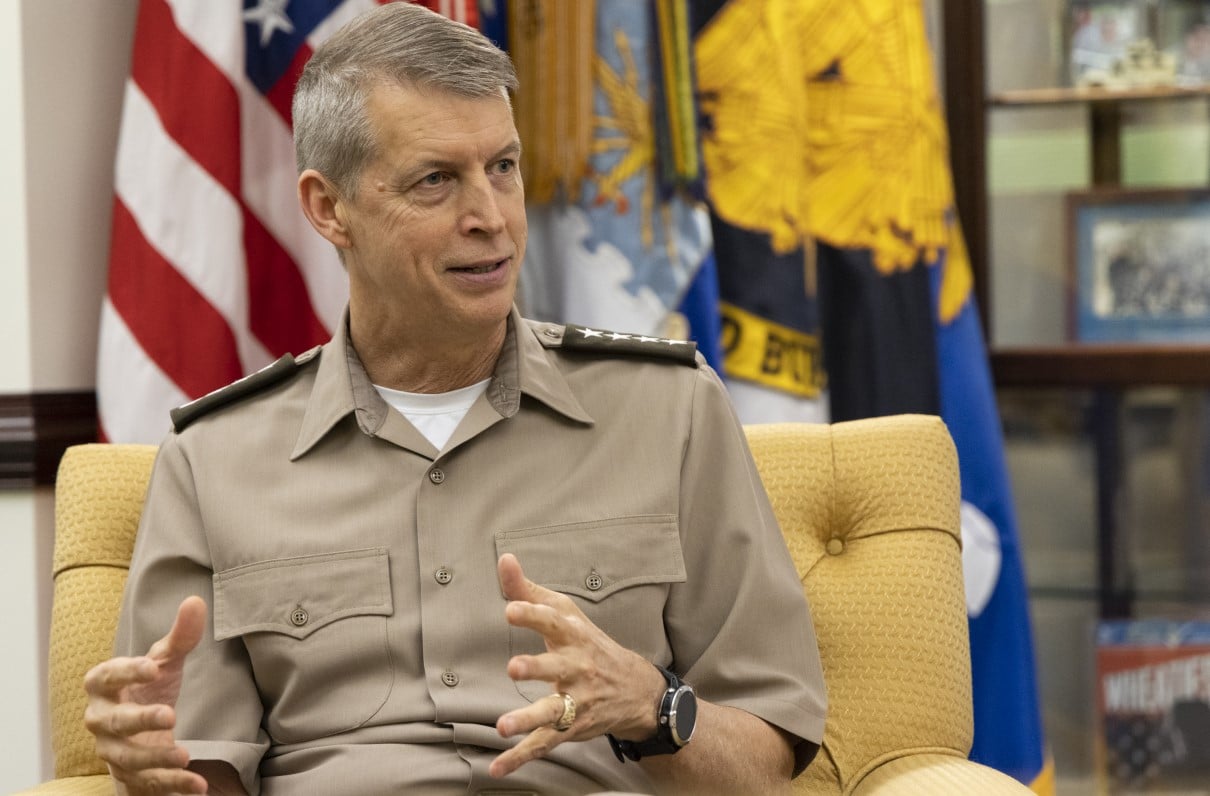(This article by Hope Hodge Seck originally appeared in the August 2023 issue of Military Officer, a magazine available to all MOAA Premium and Life members. Learn more about the magazine here; learn more about joining MOAA here.)
With nearly four decades of service in the military, Gen. Daniel Hokanson is focused on planning for the future of the National Guard. Currently serving as the 29th chief of the National Guard Bureau, the U.S. Military Academy at West Point, N.Y., graduate is approaching the end of his tenure as chief in the next year or so.
Military Officer sat down with Hokanson in May to discuss his priorities, including closing the gap in health care benefits, boosting recruitment, and modernizing the force. The following interview has been edited for length and clarity.
Q. You became chief of the National Guard Bureau in 2020, and you’re in your last year or so of your tenure. It certainly hasn’t been a boring time. What are [your] remaining goals?
A. I have so much that I’m trying to get done in that amount of time. ... My priorities really haven’t changed at all: people, readiness, modernization, and reform. And we continue to work on those things that really mean the [most] to our people and taking care of them.
One thing we’ve been working on is health care for all of our guardsmen. In a 2019 survey, we had about 60,000 without health care. So we really want to do everything we can to educate everyone on trying to close that gap. Because, like all National Guardsmen, our motto is, “Always ready, always there.” ... But you can’t surge medical readiness. It’s got to be preventive care. It’s got to be seeing a doctor when you’re injured or sick.
[Equipment] readiness really is advocating for the resources with the Army and the Air Force. Modernization is, as we transform into new equipment, [making] sure that the National Guard gets transformed as well. ... [We] have to be able to be a part of whatever our nation asks our military to do.
Q. The face of the National Guard is changing, just as the country is changing. How is the Guard evolving to meet the needs of the country, DoD, and the people who serve in it?
A. The founding of the Guard was back in 1636. We’re probably one of the oldest, if not the oldest, institutions in America. So our ability to stay relevant [and] capable and meet the needs of our country over hundreds of years has been really important.
When we look forward, when we look at our guardsmen, they’ve got to be able to balance their civilian career, their military career, and their family so that they can serve. ... But we need to find that balance, so they don’t have to start choosing between two of the three or one of the three. ... And my goal here is to make sure that on our staff, we do everything we can to support them.
Q. You’ve been consistently beating the drum on health care. How optimistic are you the Guard will get the policy change for which you’re advocating?
A. We work with our congressional leadership every chance we can to really highlight the issue. ... We’re trying to demonstrate toward congressional leadership generally what we think the bill is, because we think it’s a lot less than what they anticipate it could be. But then on the other end, what we’re trying to show is the readiness that’s gained from that. And when you look at the ability to recruit and retain in today’s environment ... these are some things that we have to consider providing as a benefit to attract the kind of people we want.
Q. Recruiting in the Guard is trending upward, even as the broader military continues to struggle in this area. What recruiting messages are resonating?
A. Everywhere I go, I’ll stop purposefully and spend about 30 minutes to an hour with recruiters. And I’ll talk to them about what’s working and what’s not working. ... What I think what we’re finding over time is we’ve kind of had the cumulative effects of COVID, not having access to schools.
Now, we’re coming out to a very strong economic environment where there’s a high demand for employees, so there’s a lot of competition for them as well. We’re not going to declare victory, because we’ve got a long way to go.
Q. What’s at the top of your modernization wish list?
A. It’s fighters. We have 25 fighter squadrons in the Air National Guard. And when you look at the demand globally for fighter aircraft, we really need to keep all 25 fighter squadrons. We’ve been working with the Air Force and our Air National Guard team as we purchase new aircraft, cascading the newest older stuff into the Guard and then also upgrading what we have in the Guard, F-35 and F-15EX. And we think we have a plan now. We’d have to reduce the number of aircraft assigned until we have enough, but what we’re really trying to do is retain that capability.
Q. What are the biggest challenges to meeting that objective?
A. It’s getting the resources to buy those aircraft. I think the Air Force has a plan over the [next five years]. ... And as we’ve seen with our C-130 fleet, if Congress buys more, it gets us to that point faster. But at the end of the day, we have aircraft that we need to get rid of. And by showing each of our squadrons a path to a future aircraft, I think that will allow us to divest the older airframes and then bring in and transition to the newer ones as quickly as we can.
Hope Hodge Seck is a writer on military issues who is based in the Washington, D.C., area.
Military Officer Magazine
Discover more interesting stories in MOAA's award-winning magazine.


